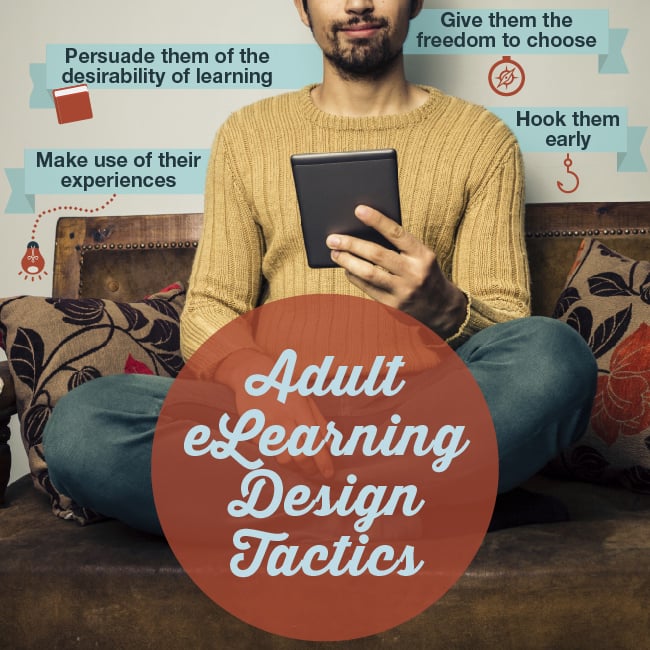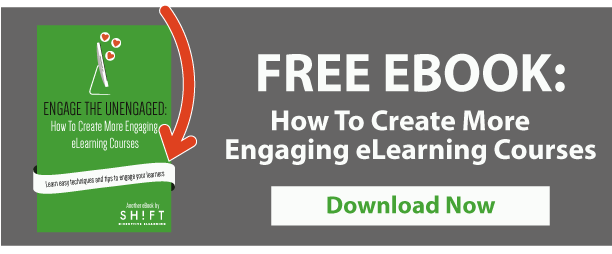Most of adult learning strategies are based on the idea that adults learn differently from non-adults. The term that often comes up is “androgogy,” which Malcolm Knowles coined to describe how adults learn in contrast to “pedagogy” or on how children learn.
The fact is, we already know a lot of theories surrounding adult learning. The problem is, many courses still don't take into account what these theories entail—and often don't successfully apply androgogy strategies for maximum performance.
Understanding how adults learn, is the first step to crafting an eLearning material adults will actually want to start and finish. By recognizing how they learn best—including certain adult traits and learning behaviors—instructional designers are in a better position to create more value.

1) Hook Them Early—and Often.
Make that first, strong impression a positive one. It's really the first impression that allows adult learners to find an emotional connection to the subject you're presenting. Once learners are hooked into the lesson, there's no turning back. Also, it's not just a matter of making them pay attention to your screens or content. It's also necessary that learners are actively involved all throughout the process. Here are only four of the many ways to successfully engage adult learners:
- Tell them a good story: The best political speeches and the greatest graduation speeches share a common element: a good, human interest story. It's arguably one of the easiest ways to emotionally connect with your audience. And you can surely tell one that presents a scenario similar to that of your adult learners—one that keeps them on the edges of their seats.
- Create an enjoyable and fun learning experience: It's no secret that adults learn best when they're steeped in an enjoyable, fun environment. Instead of passively listening to long, boring lectures, they're drawn to engaging stories and active discussions. The operative term here is active. Something within their learning environment should motivate them to actively apply prior learning.
- Interactivity: In addition to making the learning experience active, there's also a need for an "interactive" eLearning environment. Rather than memorizing code sections, adults would retain and apply knowledge more effectively if they worked to discover the content, and then were able to practice its application in a simulation or scenario. Let them play an educational game. Allow them to download materials in portable, interactive format.
- Compelling visuals: Like kids, they also find colors and compelling visual elements exciting. If you rely heavily on text-based elements or the usual black-and-white presentation filled with paragraphs, they're likely not going to finish your course.
2) Make Use of Their Experiences
Adult learners have a vast collection of experiences, which they can draw from or relate to during their learning process. They can, for instance, tap prior learning and connect it with new ideas.
The challenge is to make them apply what they already know. A simple “what if” exercise, with the help of a relatively inexpensive design software, can effectively help you achieve this. A simulation course designed for marketers, for instance, can include realistic situations that allow them to improve their skills and apply prior learning. Including other experiential techniques such as role-playing, real life case studies, group discussions, and demonstrations can help too. These activities will allow learners to be active participants in the learning experience (after all that's what they prefer).
There's nothing mysterious about this really. You only have to give learners as many opportunities as you can for bringing their previous experiences into the new material.
3) Persuade Adult Learners of the Desirability of Learning Something
Selling people on "why" they need to learn something new is quite hard. But this fine art of selling—or of persuasion—can be smoothly facilitated by tapping into the desires of your adult learners.
Learning goals are good. Objectives are important. But don't forget to include your learners' desires when you understand what motivates them to learn.
Ask them what changes do they want to see in themselves or at work? Give them the bigger picture, show them how the course can benefit them before tackling the details.
Also take note that there are statements that might discourage adults from applying themselves. This is one common example: “management has made this training mandatory for everyone in the company.”
Not only does this not motivate adults, it also doesn't sell to adults the idea of learning to achieve their specific desired skills and knowledge. So be sure to always relate a learning program to the adult learner's experience and position in the organization. Motivate them to do better at work.
4) Give Adult Learners the Freedom to Choose
Self-directed adult learners are highly successfully so you don't have to nudge them in the right direction. They're usually aware of the need to know something and the importance of acquiring new skills and information.
Adult learners, to some degree, are self-directed. They would all like to have the freedom to choose how, where and what to learn. Help them help themselves achieve their learning goals by involving them in the planning and design of instruction. Here are some ways to get started:
- Have some control over the course but don't hold strict control over your adult learners. Think active discussions, not straight two-hour-long lectures.
- Make flexibility a built-in feature in your material. You can, for instance, offer your content in several portable formats so that adult learners can access them across several devices.
- Offer learners clear and varying choices to the extent that it won't interfere with their learning process.
- Act as a facilitator and let students take the center stage





